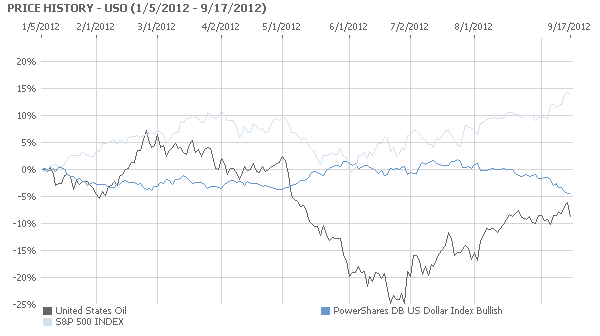The traditional safe haven assets of gold (NYSE: GLD) and silver (NYSE: SLV) have surged in price due to the announcement of the latest round of quantitative easing, QE3 - but those aren't the only assets QE3 will push higher.
While QE3 might seem harmless to U.S. consumers, it is present every time they gas up their cars or buy food at the grocery store.
In fact, all three rounds of quantitative easing have led to higher priced commodities.
Whether you realize it or not, QE3 - same as the stimulus programs before it - is adding greatly to the costs of everyday life. QE3 is directly leading to higher prices for oil, food and the cost of imported goods.
Over time, that results in a tremendous consumer expense in all product and service categories.
QE3 and Inflation
The price of oil illustrates the QE effect.
Economic stimulus measures such as QE3 lower the value of the U.S. dollar and other fiat currencies. From that, investors flee paper assets for commodities such as oil, grains and precious metals.
With economic growth projections low in the United States, China, and India, and with Europe in a recession, oil has reason to slip. But speculators, as a result of QE3, helped push the price of oil toward $100 a barrel.
Rex Tillerson, chief executive officer of Exxon Mobil Corp. (NYSE: XOM), said in testimony before Congress last year that traders had driven up the price of oil by 40%-50%.
The accompanying chart reveals how the price of the exchange-traded fund for oil, United States Oil (NYSE: USO), has risen this year as the exchange-traded fund for the U.S. dollar, PowerShares DB US Dollar Index Bullish (NYSE: UUP), has fallen.

Paradoxically, United States Oil started rising in the June-July period when poor economic data was reported for the U.S. economy.
That should have sent the USO falling due to a perceived lack of demand. Instead, United States Oil rose due to expectations of QE3 being initiated.
Higher oil prices have a multiplier effect that can be felt in other industries.
For example, fuel costs account for about 40% of the expenses for an airline. When oil prices rise, air carriers pass the costs on to fliers in the form of higher ticket prices.
That happens with any item having to do with the transportation industry.
QE3 will also result in higher costs for imported goods, adding to the inflationary surge.
When the U.S. dollar falls in value, foreign-made products rise in cost. Goods priced in the U.S. dollar fall in price in international trade while those denominated in Japanese yen rise in cost, as an example. While that is good for American exporters selling Fords abroad, it is bad for U.S. consumers seeking to buy a Toyota that was made in Japan.
The greatest impact of QE3, however, could be at the voting booth on Nov. 6.
Ironically, Republicans opposed the introduction of QE3 as it led to a stock market rally that could help President Obama win re-election.
But incumbent presidents don't fare well during gas-price spikes: Ford fell in 1976, Carter lost in 1980, and Bush was defeated in 1992.
Gas prices have risen more than 50 cents in the past two months. The increase in gas prices in August was the biggest one-month jump in overall consumer spending in three years.
Coupled with higher food prices and the rising costs of foreign goods, the inflationary spiral from QE3 could be the great incumbent slayer come Nov. 6.
Related Articles and News:
- Money Morning:
QE3 Risks: Why this Harvard Economist Fears More Stimulus - Money Morning:
Jim Rogers On QE3, Gold, Silver and Oil - The New York Times:
The High Cost of Gambling on Oil - The Dallas Morning News:
Rising gas prices dampen Americans' spending
[epom]


